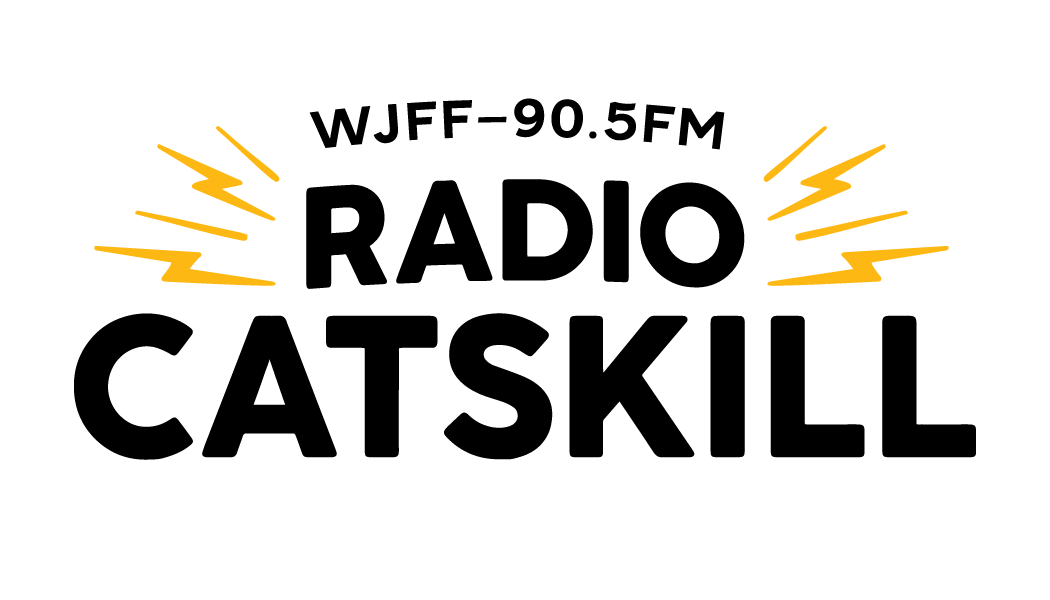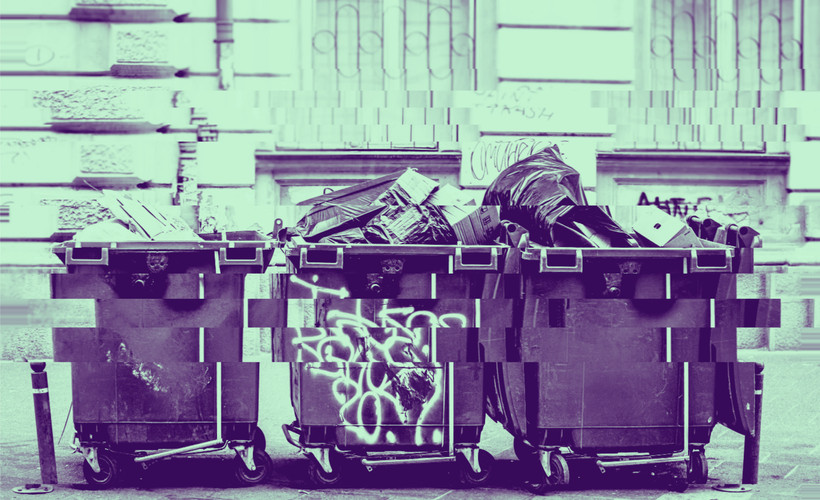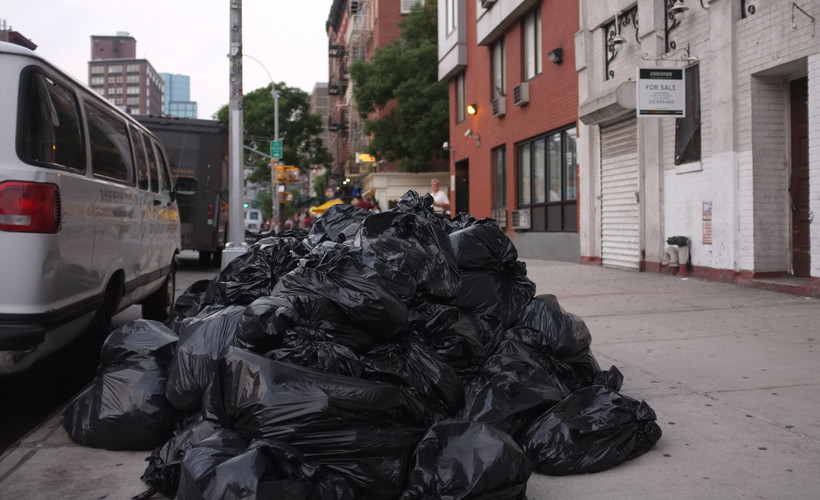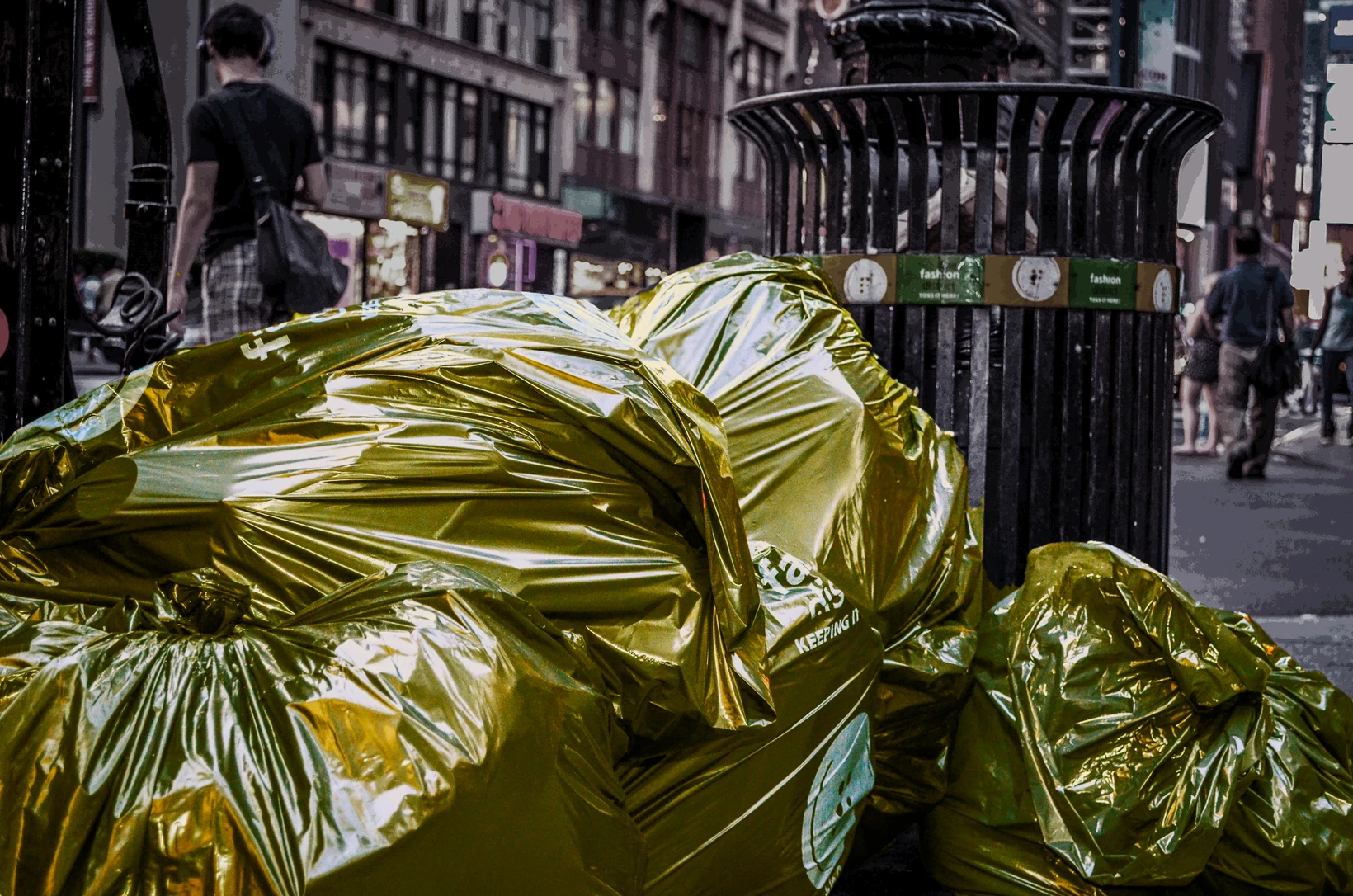
New York state produces so much trash, it’s running out of places to put it. | Photo: m01229 via Flickr / Illustration: Maia Hibbett
This story originally appeared in New York Focus, a non-profit news publication investigating how power works in New York state. Sign up for their newsletter here.
NEW YORK’S LANDFILLS are reaching their limit.
The state’s largest dump, in the Finger Lakes, is due to run out of space in 2025, but it’s asking regulators to let it pile trash higher and capture more methane. On Long Island, a major landfill overlooking a majority Black and Latino neighborhood is set to close in 2024, so the area’s main waste hauler wants to ship more trash off the island, fueling fresh environmental justice concerns.
And the trash takes a toll on the climate: As of 2019, waste accounted for about 11 percent of the state’s greenhouse gas emissions, driven mainly by food scraps and other organic materials that release methane as they rot.
Pretty much everyone agrees that New York has to stop producing so much garbage. But how? State regulators are coming around to a familiar idea: Put a price on it.
Waste haulers and some counties are already lining up to oppose the plan — and some waste experts don’t think it goes far enough.
In the published draft of a waste plan that the state is updating for the first time since 2010, the Department of Environmental Conservation (dec) has called on the legislature and the governor to adopt a statewide fee on every ton of trash that doesn’t get recycled or composted. This surcharge is one of the plan’s three key recommendations, along with making companies reduce packaging waste and expanding food scrap recycling.
While some details remain hazy, in broad strokes, the dec is proposing to charge major waste facilities for every ton of trash they process or ship out of state for disposal. Depending how the policy is implemented, that cost could potentially be passed down to consumers. Every year, the fee could raise and redistribute tens of millions of dollars for recycling, composting, and other waste reduction efforts, ideally while compelling residents to scale back what they throw out.
“Over 30 states already use some form of this successful fee structure,” the draft waste plan reads. “It is time for New York State to act.”
The urgency is clear. But the proposed fee is relatively modest. Though the draft waste plan does not recommend a specific surcharge, it says that even $5 per ton could be effective.
“We would never imagine that we could use unlimited energy or water and pay the same utility fee.”
—BRENDA PLATT, INSTITUTE FOR LOCAL SELF-RELIANCE
David Tonjes, a professor at Stony Brook University and a landfill expert, doubts it. At $5 a ton, the average household would owe less than $10 a year, even if the full cost were passed on to residents.
“People might grumble a little about having to pay it, but it likely would not serve as a disincentive,” Tonjes said.
Proponents of the surcharge say even small fees can go a long way, by putting the “polluter pays” principle to work.
“We would never imagine that we could use unlimited energy or water and pay the same utility fee,” said Brenda Platt, director of the compost program at the Institute for Local Self-Reliance. So why do we treat trash that way?
WHEN NEW YORK last released a Solid Waste Management Plan in 2010, the state’s trash situation was, by its own admission, discouraging. The amount of trash generated per person was high, the recycling rate was low, and the state was relying heavily on overburdened landfills and incinerators or shipping it out of state.
New York promised to do better. Within a decade, it aimed to slash the amount of waste New Yorkers produced by more than half.
Thirteen years later, the amount of trash disposed per person per day has shown few signs of slowing. According to data collected by the Waste Business Journal, per capita waste disposal had increased slightly by 2022. New York state’s numbers only go through 2018, and they show that the recycling rate improved somewhat — from about 36 percent in 2010 to 43 percent in 2018 — but remains below the 50 percent target set in 1987. Household recycling rates have actually declined somewhat in the last decade.
More than 30 states already impose some type of fee on the disposal of solid waste. State-level fees, like the kind New York is considering, range from $0.50 to $13 per ton and are usually applied at major choke points for trash, like landfills, incinerators, and transfer stations. Waste haulers and municipalities may pass the costs on to local residents and businesses — though in some cases, the fees are low enough that residents may not even notice.
Wisconsin has by far the highest state surcharge in the country — $13 per ton since 2009. In the last 15 years, the amount of trash the average Wisconsinite sends to a landfill has declined more than a third, according to a New York Focus analysis of state data.
New York City’s Solid Waste Advisory Boards and a coalition of environmental groups are pushing for $15 a ton, increasing $2 every five years.
According to Tonjes, it’s a delicate balancing act. For a fee to meaningfully change behavior, it would need to be high enough for municipalities, businesses, and residents to feel it, but not so high that it increases illegal dumping and noncompliance.
“If the fee was too high, you might see an increase in illegal dumping, especially upstate and with construction and debris,” Tonjes said.
Even if new fees don’t change people’s habits on their own, they could raise revenue for other waste-reduction efforts — as other states have shown.
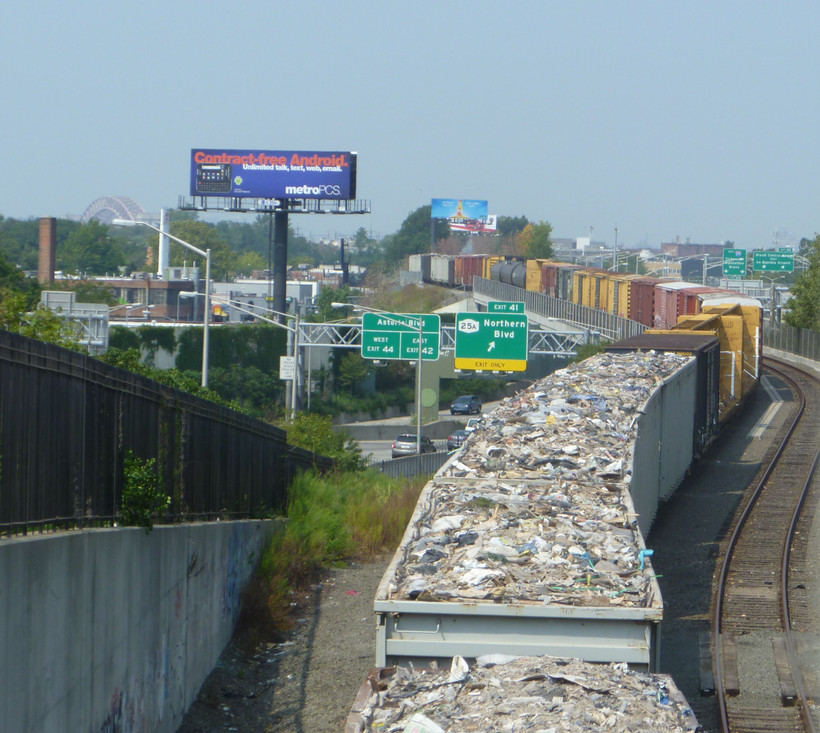
New Jersey redistributes its surcharge income to municipalities and counties for recycling and anti-waste efforts. Pennsylvania uses some of its revenue to fund water protection. Alameda County, California, has used steep disposal fees alongside a suite of other policies — including mandatory composting for businesses — to cut the amount of waste sent to landfill in half since 1995, even as the population has steadily grown.
Such fees are “a proven mechanism,” said Platt. “You don’t have to completely reinvent the wheel.”
In New York, even an initial $5 surcharge could bring in over $130 million per year for recycling and waste efforts.
And it could nudge municipalities to create or step up their own volume-based waste collection programs. Many municipalities cart residents’ waste out for disposal themselves, rather than relying on private haulers, so the towns would have to pay the extra fee at the dump. They could try to cover the expense in their existing budgets — or they could implement a related approach known as “pay as you throw,” through which they’d charge residents based on the amount of garbage they put out.
This system brings the incentive to reduce waste down to the household, and it’s popular at the local level. According to economist Lisa Skumatz, nearly 9,000 municipalities and counties — covering 40 percent of the us population — have adopted pay as you throw policies since the early 1990s.
Those policies have succeeded in reducing waste, Skumatz has found, diverting 17 percent of trash that might have gone to landfills or incinerators. And some areas that already employ them have welcomed the proposed state surcharge.
Tompkins County, in comments to the dec, said this “further financial incentive” could reinforce its pay as you throw system, which requires residents to buy tags for every bag of trash.
For now, pay as you throw is mostly limited to small towns in New York, but big cities have considered it. As early as 2015, New York City recommended putting a price on residential trash pickup and hired a consultant to study it in 2018 — then put the study on hold. The city now opposes the concept over concerns it would fuel illegal dumping, a fixation of the Eric Adams administration.
“We believe that charging for residential Sanitation services would not be the right approach, as it would lead to an increase in this crime, a theft of public space that disproportionality affects outer-borough and low-income neighborhoods,” said Department of Sanitation spokesperson Vincent Gragnani.
In Troy, “pay as you throw” nearly made it into the city budget in 2020 but was scrapped over concerns that it could increase costs to residents — especially low-income tenants — and lead to more illegal dumping. Albany hiked trash fees on businesses and apartment buildings in 2016, but long-standing proposals for a citywide fee remain in limbo.
Now, some of the backlash that has dogged “pay as you throw” locally could go statewide. Fulton County passed a resolution in May blasting the dec proposal as an “unnecessary and unfair mandate” that would duplicate the county’s existing fees. Madison County passed a similar resolution in March. And New York’s main waste industry trade group has voiced similar concerns, calling the idea a “new tax on waste.”
Advocates counter that funding waste reduction efforts through dedicated fees could actually save residents money — rather than “burying” the costs in taxes.
“Local governments can’t really control their cost on garbage [when it’s] unlimited,” said Platt. “So we need that direct economic incentive at all levels.”
WHILE A STATEWIDE WASTE fee could help, experts agree it can’t solve New York’s trash problems by itself. New York lags behind states like Maine, Vermont, and California, all of which have passed major anti-waste laws in recent years and send less waste per person to landfills, incinerators, or export.
The dec and many advocates rank “extended producer responsibility” (epr) — which aims to tackle the waste problem higher up the supply chain — as a top priority.
According to Judith Enck, president of the advocacy group Beyond Plastics and former regional administrator at the us Environmental Protection Agency, “the single most important thing” New York can do is adopt the Packaging Reduction and Recycling Infrastructure Act, an epr bill that would require a 50 percent reduction in packaging over the next 12 years.
“It puts responsibility directly on the generators of the waste,” she said.
Enck also stressed the importance of expanding statewide food recovery and composting efforts.
Senate environmental committee chair Pete Harckham shares those priorities. He championed packaging epr and expanded food scrap recycling in the legislature this year, but neither bill passed. It was the fourth year in a row that epr legislation failed.
Next year, he told New York Focus, “my efforts are going to be on reducing the amount of waste that goes [out], not necessarily charging our consumers and our taxpayers and our small businesses more.”
But he said he would be open to a well-crafted surcharge policy if the governor were to include one in her budget.
“It’s still conceptual,” Harckham said, but the budget would be “an opportunity for them to put pen to paper.”
Asked whether a surcharge was on her agenda, Governor Kathy Hochul’s office was noncommittal.
“Governor Hochul is committed to protecting our environment,” a spokesperson said. “Further information will be announced in her Executive Budget early next year.”
